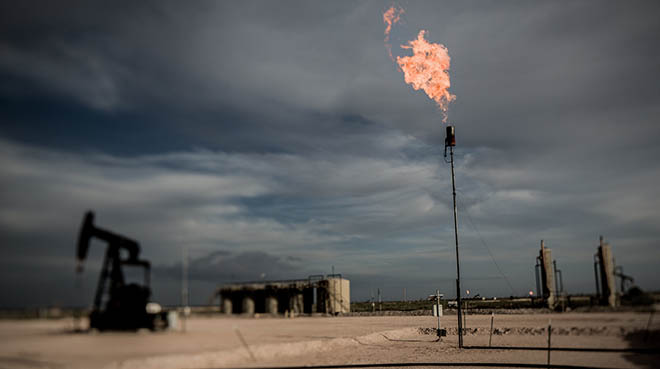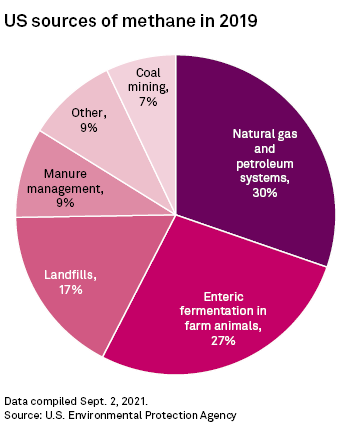
| Excess natural gas is flared at a Texas well in the Permian Basin. Source: Blake Thornberry via Flickr |
The amount of methane being released from oil and gas fields in the Permian Basin is now consistently at pre-pandemic levels, according to researchers who collected new data this summer ahead of upcoming federal emissions regulations.
Emissions of the gas in the oil-rich region in Texas and New Mexico normally fluctuate with production. But even the relatively low readings taken July 31 of 123.2 metric tons of methane released per hour were significantly higher than the 84.3 metric tons registered on April 4, 2020, when the economy first dipped.
The peaks in methane emissions are also back to where they were before the coronavirus pandemic curtailed demand for oil and gas and production declined, data gathered by the Permian Methane Analysis Project showed. A study released this spring also confirmed that the decline in emissions was short-lived.
The findings come on the heels of a high-profile report from the Intergovernmental Panel on Climate Change that urged "strong, rapid and sustained reductions" in greenhouse gases, especially methane.
Researchers with the Environmental Defense Fund, the group that spearheaded the Permian methane initiative, said the data builds a case for the U.S. Environmental Protection Agency's upcoming new emissions restrictions for oil and gas production sites, slated to be proposed this month.
"The EPA has an excellent opportunity to build regulations that would address the sorts of problems we're seeing in the Permian," said Jon Goldstein who leads the Environmental Defense Fund's oil and gas regulatory and legislative affairs. "Putting in place comprehensive regulatory requirements that apply evenly across all wells that don't include any sorts of exemptions for any classes of wells — and that build on approaches that have been taken by states like Colorado, New Mexico and Wyoming — that's all very much on the table."
EPA chief aims for 'deep cuts' in methane
The oil and gas industry and its main lobby group recently indicated they may be on board with new methane restrictions, a shift from their staunch opposition to such policies. Representatives from the American Petroleum Institute have been meeting with EPA Administrator Michael Regan, National Climate Advisor Gina McCarthy and other key members of the Biden administration in recent months to discuss the upcoming rule.
"We will continue working with policymakers on both sides of the aisle in support of sensible regulations that will further methane emissions reductions," Kevin O'Scannlain, the American Petroleum Institute's vice president of upstream policy, said in a Sept. 2 statement.
Regan, meanwhile, has been frank about the EPA's marching orders.
"Per the president's executive order, we will propose new strong standards to reduce methane emissions from new and existing oil and gas sectors that's going to be something that has never been done as aggressively as we plan to do it," the EPA chief said at an Aug. 30 Resources for the Future event. "We're going to focus on the oil and gas industry and really look for deep cuts in emissions of methane."

With immediate and sufficient cuts in methane pollution from the fossil fuel and agricultural industries, the world could make significant progress toward limiting a potent driver of global warming, scientists said. While a relatively short-lived pollutant in the atmosphere, methane carries 82 times the warming punch of carbon dioxide for 20 years after first being released.
Methane concentrations in the atmosphere increased by 156% between 1758 and 2019 mainly due to human activities, Vaishali Naik, the lead author of a section on short-lived climate pollutants in the recent IPCC report, told a U.S. House of Representatives committee Sept. 1.
"And this increase in methane is far greater than the natural, multi-millennial changes ... over at least the past 800,000 years," Naik told the House Select Committee on the Climate Crisis.
Unlit flares and methane leaks rising
The Permian Methane Analysis Project uses satellite, fly-over, drive-by and tower data on an interactive map to show the operators that release methane and the level of those releases in a section of the Permian known as the Delaware Basin. The area accounts for 40% of the oil and gas produced in the Permian Basin and includes major producers like Exxon Mobil Corp., Royal Dutch Shell PLC, Chevron Corp. and Occidental Petroleum Corp.
Unlit flares of excess natural gas from oil wells are increasing in the Permian Basin, as well as in the Williston oilfields in the Montana and South and North Dakota region, according to the EPA's most recent greenhouse gas inventory. The same trend was true for the Gulf Coast basin of Texas and Louisiana. Between 2015 and 2019, methane emissions from unlit or malfunctioning flares nationwide rose 65% to nearly 82,000 tons, the agency reported.
Operators sometimes release natural gas — which is largely composed of methane — that they cannot sell, often when there is insufficient pipeline capacity to move the gas to market. By igniting the methane through a flare, it is released into the atmosphere as carbon dioxide, a less potent greenhouse gas in the short term.
Overall, methane emissions from the U.S. oil and gas industry have declined since 1990, falling about 20% for petroleum systems and 15.7% for natural gas systems over that time, according to EPA data. In recent years, there has been an uptick in sector emissions, however, according to EPA data. Specifically, petroleum systems emitted about 4.8% more methane in 2019 than the year prior, and natural gas systems were responsible for about 3.3% more methane emissions over that period, the EPA's most recent inventory said.
The Environmental Defense Fund has disputed some of the EPA's methane data. Helicopter surveys commissioned by the group in 2020 captured infrared images from hundreds of oil and gas production sites in the Permian basin, suggesting that emissions in that region alone were more than three times higher than EPA estimates, the group reported.



